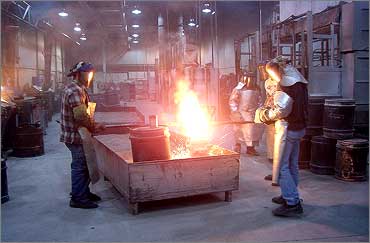Melting
The melting process begins with the customer's metal specification for the casting, which determines what type of scrap metal will be used to 'charge' the furnace. Once charged, the furnace uses electricity, to melt the scrap metal. At various points in the melt process, samples are taken to determine the chemical composition of the molten metal. Using a Spectrometer as a guide, alloys are added to the furnace to bring the molten metal in the proper specification.
Once the metal is within the desired specification, and at a temperature near 3,000 degrees F., it is poured into a preheated ladle for transfer to the pouring lines.
At the pouring lines, molten metal is 'poured' into the appropriate molds. Due to the lifting pressure of molten steel, molds will often be 'weighted' or 'clamped' to prevent them from separating at the Cope/Drag meeting point.
After pouring, the mold is allowed to cool for approximately 30 minutes before it is taken to the shakeout. At AGMF, poured molds are dumped into a vibrating conveyor. In the conveyor, the molds are broken up by the vibration, which exposes the casting for removal. The sand from the mold is separated and process through a reclamation system for reuse in mold and core making.





